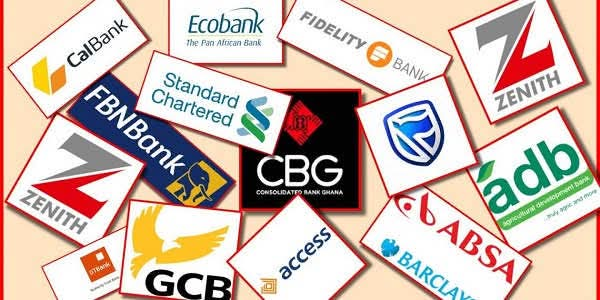Ghana’s banking industry has delivered one of its most profitable half-year performances in recent memory, with profit-after-tax soaring by 32.6 per cent to GH¢7.2 billion as of June 2025.
The latest Monetary Policy Report released by the Bank of Ghana in July 2025 paints a picture of an industry that has managed to expand profitability across nearly all income lines, even as cost pressures persist and economic headwinds remain.
The figure compares favourably with the 25.5% growth recorded in the first half of 2024, suggesting that the recovery trajectory of the banking sector—following the disruptions of the Domestic Debt Exchange Programme (DDEP) in 2023—is gathering momentum.
Pre-tax profits also surged by 32.2% to GH¢10.8 billion at the end of June 2025, up from GH¢8.1 billion in June 2024.
According to the central bank, this strong growth was driven primarily by increased net interest income, higher fees and commissions, and a sharp rebound in other income streams.
The drivers: Interest income and fees
The report shows that net interest income, the backbone of bank earnings, climbed by 20.2% to GH¢14.2 billion in June 2025, compared with GH¢11.8 billion a year earlier. This rate of growth slightly exceeded the 19.4% expansion recorded in June 2024.
Total interest income reached GH¢21.6 billion, representing a 20.4% increase from GH¢18 billion in June 2024.
The central bank attributed this performance to relatively higher yields on money market instruments during the first half of 2025 and elevated lending rates charged by banks.
The cost of funds, however, also went up.
Interest expenses jumped to GH¢7.5 billion in June 2025, marking a 20.7% increase compared with GH¢6.2 billion in June 2024.
This was marginally higher than the 18.6% growth recorded in the same period last year, highlighting the rising cost burden banks face in mobilising deposits and wholesale funds.
Beyond interest income, net fees and commissions also contributed positively.
They recorded a growth of 17.8% in June 2025, an improvement from 16.8% a year earlier.
This steady expansion reflects increased volumes of transactional activity, higher charges on services, and a gradual rebound in trade-related banking services.
What stood out in the income mix, however, was the sharp rise in “other income.”
The category soared by 52.2$ to GH¢3.6 billion in June 2025, compared with GH¢2.4 billion in June 2024, when it had contracted by 16.2%.
Analysts suggest that this surge may have been driven by gains from foreign exchange trading, revaluation profits, and other ancillary business lines as banks diversified revenue sources to withstand macroeconomic volatility.
Overall income growth
With all major income lines improving, the industry’s operating income rose to GH¢20.9 billion in June 2025, up from GH¢16.8 billion in the previous year.
This represents a growth rate of 24.4 per cent—nearly double the 12.3% recorded in June 2024.
Gross income also rose strongly, hitting GH¢28.3 billion in June 2025, compared with GH¢23.0 billion a year earlier.
This equates to a year-on-year growth of 23.4%, significantly higher than the 14% growth recorded in June 2024.
“The broad-based growth in income lines reflects an industry that is regaining confidence, leveraging higher market rates, and expanding service offerings to clients,” the Bank of Ghana stated in its report.
Rising operating costs
Despite the robust revenue growth, banks are grappling with higher costs.
Operating expenses rose by 21.4% in June 2025, compared with 15.5% in the same period of 2024.
The increase was largely on account of rising staff costs, higher administrative expenses, and inflationary pressures that have affected the cost of running branch networks and digital operations.
Nonetheless, banks continued to benefit from declining impairment charges.
Impairment losses on financial assets, provisions for bad debts, and depreciation contracted by 14.8% in June 2025, following an even steeper contraction of 39.5% in June 2024.
The slower pace of contraction suggests that while banks have reduced their provisioning relative to the immediate post-DDEP period, some caution remains in relation to credit risks and asset quality.
Sector is in recovery mode
The first-half 2025 results mark a significant turnaround for an industry that faced immense strain just two years ago.
In 2023, the government’s debt restructuring exercise resulted in massive impairment losses on government securities—the largest component of bank assets.
This pushed many banks into losses and eroded capital buffers, forcing some institutions to restructure their balance sheets.
By 2024, the sector began showing signs of gradual recovery, buoyed by recapitalisation efforts, regulatory forbearance, and a stabilising macroeconomic environment.
The GH¢7.2 billion profit-after-tax recorded in June 2025, therefore, signals that the sector has not only recovered lost ground but is once again posting double-digit growth in profitability.
Implications for stakeholders
For shareholders, the stronger profitability raises prospects of improved dividend payouts and enhanced returns on equity, provided banks meet regulatory capital adequacy requirements.
For depositors, the stability of the sector reinforces confidence in the safety of funds and continuity of services.
From a macroeconomic perspective, the banking sector’s performance is crucial.
With gross income of GH¢28.3 billion and profit-before-tax of GH¢10.8 billion, banks are better positioned to support credit growth and finance private sector activity, though the high lending rates remain a concern for businesses.
Analysts also caution that while profitability is rising, the quality of earnings matters.
Heavy reliance on interest income—particularly from government securities—could expose banks to concentration risks if market conditions shift. Diversification into transactional banking, digital services, and trade finance will therefore be critical in sustaining earnings growth.
Outlook for the rest of 2025
Looking ahead, the outlook for the banking industry will hinge on the trajectory of interest rates, inflation, and the cedi’s exchange rate performance.
With the Bank of Ghana maintaining a tight monetary stance to anchor inflation—now down to 9.4% in September 2025—yields on government securities are expected to remain relatively attractive, sustaining bank income from investments.
At the same time, the private sector is likely to face continued pressure from high lending rates, potentially slowing credit expansion.
While the central bank’s report shows that impairments are declining, non-performing loans (NPLs) remain a structural challenge that could resurface if economic growth falters.
The Bank of Ghana has reiterated its commitment to monitoring risks and ensuring that banks remain adequately capitalised, liquid, and resilient in the face of shocks.
The banking sector’s half-year results for 2025 demonstrate remarkable resilience and recovery, with profit-after-tax rising 32.6% to GH¢7.2 billion and profit-before-tax hitting GH¢10.8 billion.
Supported by GH¢14.2 billion in net interest income, GH¢3.6 billion in other income, and GH¢20.9 billion in operating income, banks have managed to post their strongest half-year results in years.
Yet challenges remain: operating expenses are rising, the cost of funds is increasing, and the need to diversify away from government securities is becoming more urgent.
Still, the results show that Ghana’s banking sector has weathered recent storms and is once again a cornerstone of economic stability.
For now, industry watchers agree on one point—the first six months of 2025 have placed the banking sector on a solid path, with the potential to consolidate growth, expand credit, and reinforce confidence in the broader economy.













